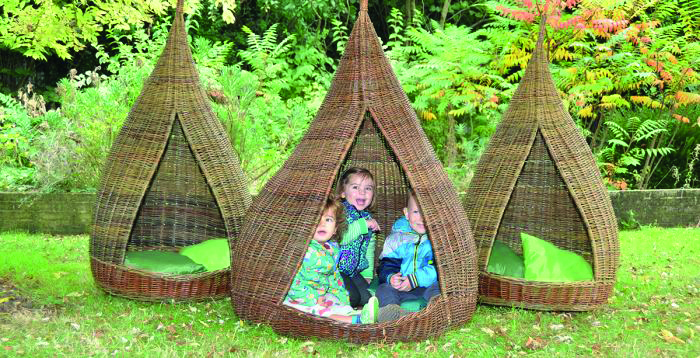
Before thinking about how you want to resource your setting to encourage communication and language, you first need to consider your physical environment. The best way to support speech and language development is to do lots of talking together, and for this to happen you need to create a place where children feel calm, safe and stimulated. Background noise also needs to be kept to a minimum because environments where sound travels or creates an echo can be disrupting to a child’s communication.
Rugs and carpets, soft materials and cushions help absorb noise and create cosy spaces. Children need small intimate spaces where they can snuggle up and chat with one or two friends, both indoors and outdoors. Also, think about the zoning of your nursery and try to put quieter activities such as the reading area away from noisier ones, like the construction area.
Room dividers and furniture can be positioned to create boundaries and pathways to encourage children to move and explore while also helping them to be involved in activities without disruption.
PRACTITIONER’S ROLE
When it comes to resources, children are much more likely to enthusiastically engage in conversation if it is something that excites them. Think of all the language opportunities you can have with a child who is enthused by trains – from exploring the sounds a train makes to investigating the names of different locomotives and supplying new vocabulary when needed while playing with a train set.
Children’s interest in the scientific and sensory opportunities of sand and water play is also a great place to develop vocabulary. ‘Try to just be there and comment on what is happening rather than ask questions,’ advises early years consultant Helen Moylett. ‘For example, commenting “You are digging a deep hole” rather than asking “What are you doing?”’
Exploring sounds
Listening skills go hand-in-hand with talking skills so children need lots of opportunities to develop these too. Practitioners need to model that a conversation is a two-way process of listening and speaking.
‘Being able to listen carefully to one sound or voice among background noise is a skill that has to be learned,’ says Ms Moylett. ‘Use everyday sounds, buy or make sound and music making toys, such as push-button toys, sound-makers and simple shakers. Use simple recording devices, such as Talking Tins for children to record and hear their own voices and those of others.’
Fun ways to encourage listening include:
- Sound lotto games.
- Microphones.
- Recording equipment.
- Audio books and rhymes.
- Musical instruments.

Books
A favourite book is very powerful for getting children to tune in, repeat fun refrains and recreate the story through play. Ms Moylett recommends choosing books with repetition and good quality text and illustrations. ‘The way you use any book should acknowledge and extend children’s experience and develop vocabulary,’ she says. Ms Moylett advises:
- considering the questions and prompts you could use to encourage children to think and talk about the story
- asking open-ended questions and recasting what children say
- thinking about new vocabulary you will introduce while reading and talking about the story
- planning follow-up activities to consolidate vocabulary
- sometimes letting the children be in control of the story and you be the listener.
Bring popular books to life by using story sacks or introducing resources, such as a straw, sticks and bricks for The Three Little Pigs.
Songs and rhymes
Ms Moylett recommends sharing songs and rhymes to enable children to hear repeated languages, tunes and rhythm while also encouraging listening and responding. Challenge staff to learn more songs, rhymes and action games – such as ‘Simon Says’ or ‘Head, Shoulders, Knees and Toes’.
Imaginary play
Traditionally imaginary play has been enclosed in designated areas, but many settings now offer children the opportunity to set up scenarios both indoors and out. Imaginary play often encourages children to talk to themselves or with others about what they are doing or what is happening.
It is preferable to have a small selection of quality small-world resources that can be grouped together and link to the children’s interests, such as:
- Transport, including tracks, roads or runways.
- Wild animals or farm animals.
- Dinosaurs.
- Dolls’ houses with people and furniture.
Consider how you can creatively use backdrops, mats and natural resources such as soil and leaves in builder’s trays. You could also stick children’s photos to wooden characters or pegs so they can interact with themselves.
Create a home corner that you would be happy to move in to, then children will want to spend lots of time there interacting and re-enacting their real-life experiences. Ensure it is representative of the children in your setting – you could ask parents to donate items or search charity shops.
When planning role-play scenarios, link them to the children’s current interests, such as a bear cave in the book corner, a car wash with buckets of water and big sponges outside or a florist with pots, vases, real and artificial flowers.
Den-making and construction
While building, Ms Moylett says children are encouraged to use abstract language as they problem-solve, interact with their friends and articulate plans, evaluate and change aspects of their construction and negotiate with their peers.
CASE STUDY: Tuffkid Nursery in Barnet, North London
 ‘We’re great believers in using nature and natural objects to create an environment that is a balance between calming and stimulating and helps to support and promote children’s communication and language skills,’ says nursery manager Janice Marriott.
‘We’re great believers in using nature and natural objects to create an environment that is a balance between calming and stimulating and helps to support and promote children’s communication and language skills,’ says nursery manager Janice Marriott.
‘We have carpeted areas and hessian-covered display boards to keep noise levels down and we use lots of neutral colours. Staff are aware of each child’s communication level and use this as a starting point to consolidate and scaffold language. Open questions are used with children with higher communication levels to help them articulate ideas. Staff reflect back to the child so they know they have been listened to and understood. We use Makaton to facilitate communication with everyone.
‘Children’s interests and schemas are followed in our planning because when children are enthused they want to talk and are more receptive to learning new words. Provocations are also placed throughout the nursery to encourage communication. For example, having turnips and butternut squash, along with ginger, garlic and a variety of home-grown herbs in the home corner, provides the opportunity to explore textures, smell and taste, which brings a wealth of descriptive vocabulary. Simple wooden blocks promote conversation as children plan joint projects and negotiate how to construct a bridge or block a path.
‘Children need to develop their listening skills. We use CDs of environmental sounds or animal sounds and encourage children to match the sounds to picture cards. A favourite game is with musical instruments, with children playing a range of instruments to find the hidden one that made a sound. Different forms of telephones are also popular, including walkie talkies for the older children. We also have a “voice changer”, which we’ve found encourages reluctant talkers.
‘Our literacy area is quiet and cosy with books, soft toys and puppets. We set up classic stories with props to encourage children to develop their role play, which is often accompanied by rich descriptive language. Staff are accomplished storytellers and story times are often interactive events with story sacks or props. For example, “We’re Going on a Bear Hunt” can begin indoors and head outside with real water, mud and grass, while re-enforcing the familiar phrases and sensory descriptions.’
Resources
- Outdoor and indoor bean bags, www.earlyyearsresources.co.uk
- Room divider sets and interchangeable panels, arches and posts, www.communityplaythings.co.uk
- Moveable outdoor fences, www.costcuttersuk.com
- Cosy Pod Family Trio, www.cosydirect.com
- Talking Tins – Voice Recorders, www.talkingproducts.com
- Tune into… Environmental Sounds, www.yellow-door.net
- Who’s Speaking, Who’s Listening Telephone, www.tts-group.co.uk
- Musical instruments, www.knockonwood.co.uk
- Puppet Resource Collection, Early Excellence, www.earlyexcellence.com
- Story Sacks and Story Sets, Early Years Resources, www.earlyyearsresources.co.uk
- Realistic animal figures, www.schleich-s.com/en/GB
- Vehicle Pack and Construction Vehicles Set, www.hope-education.co.uk
- Multicultural Costumes, www.earlyyearsdirect.com
- Role Play Real Life Resource Collection, www.earlyexcellence.com









